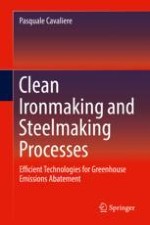2019 | OriginalPaper | Chapter
10. Electrolysis of Iron Ores: Most Efficient Technologies for Greenhouse Emissions Abatement
Author : Pasquale Cavaliere
Published in: Clean Ironmaking and Steelmaking Processes
Publisher: Springer International Publishing
Activate our intelligent search to find suitable subject content or patents.
Select sections of text to find matching patents with Artificial Intelligence. powered by
Select sections of text to find additional relevant content using AI-assisted search. powered by
